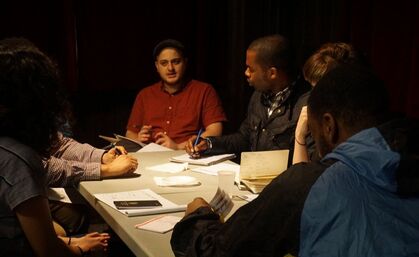Impact.
Vision Driven Artists Series Data
|
goals achieved
|
ARTISTS FEEDBACK
|
RESULTS
|
Success Stories
- A local filmmaker was awarded a $10,000 grant from Temple University after her grant application was edited at a VDA grants workshop
- A youth arts instructor got connected to 3 arts organizations at a VDA workshop and facilitated a year of programming with those groups
- A combat dancer and a harpist met at a VDA workshop and collaborated on a performance piece together
- At least 10 people who have attended our workshops have been on funding panels for local arts organizations
- VDA recommended 10 artists of color to be part of a local artist fellowship
- A visual artist was awarded a significant fellowship after receiving edits from VDA
Commitment to Diversity

Vision Driven Artists is devoted to the the acquisition and distribution of resources to artists whose identities and life experiences have systematically kept them from being first in line. These include, but are not limited to: people of color, poor people, queer, trans, and gender non-conforming folx, single parents, formerly incarcerated individuals, survivors of abuse, individuals with disabilities, and artists without "formal" education (among many other demographic groups), who have less access to funding and opportunities than their counterparts. Identity is complex, and we recognize that the language of diversity, inclusion, and accessibility can mean different things to people, and can vary based on artistic discipline.
Our definitions of access and inclusion are open to interpretation, but with specific premises in place. Namely, white people and cis-gendered men have more access to resources, across the board, in this country. In fact, Americans for the Arts reported that white people comprise 86% of all executives at local arts agencies and 83% of all arts administrators. However, context is important to us and will be a large part of the applicant review process. For example, we understand that women have been historically marginalized and underrepresented in many fields, but women (white women, specifically) are overrepresented in the fields of arts administration, dance, and arts education. Women (of all races) are underrepresented in fields of music composition, cinematography, and sound engineering.
In its inaugural year, the Arts Funding Boot Camp program data showed that the cohort demographic consisted of 89% women, 78% low income ($0-$40,000), with the largest intersectional demographic being 56% black or African American women.
Our definitions of access and inclusion are open to interpretation, but with specific premises in place. Namely, white people and cis-gendered men have more access to resources, across the board, in this country. In fact, Americans for the Arts reported that white people comprise 86% of all executives at local arts agencies and 83% of all arts administrators. However, context is important to us and will be a large part of the applicant review process. For example, we understand that women have been historically marginalized and underrepresented in many fields, but women (white women, specifically) are overrepresented in the fields of arts administration, dance, and arts education. Women (of all races) are underrepresented in fields of music composition, cinematography, and sound engineering.
In its inaugural year, the Arts Funding Boot Camp program data showed that the cohort demographic consisted of 89% women, 78% low income ($0-$40,000), with the largest intersectional demographic being 56% black or African American women.
Last night’s workshop was excellent! I came home brimming with ideas and enthusiasm for planning my next show and tour. |
I am really glad for the opportunity to focus the thinking around my creative practices and possibly change my thinking around funding it all.” -–Mandy, Workshop Attendee & Visual Artist |
|
|
CONTACT
[email protected] |
